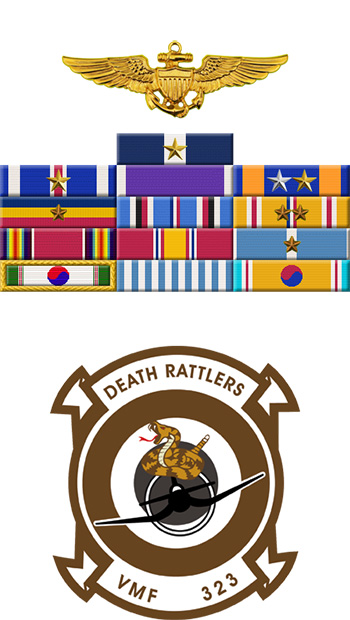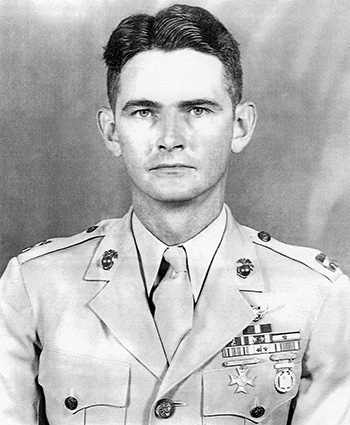
|
William P. Brown, Jr. |
 |
|||
| Rank, Service | ||||
Captain O-3, U.S. Marine Corps |
||||
| Veteran of: | ||||
|
||||
| Tribute: | ||||
William Brown was born on December 18, 1923, in Lovely, Texas. He enlisted in the Aviation Cadet Program of the U.S. Navy on September 5, 1942, and was commissioned a 2d Lt in the U.S. Marine Corps on November 16, 1943. Lt Brown was designated a Naval Aviator on December 7, 1943, and then attended F4U Corsair Combat Marine Fighter Operation Training at NAS Jacksonville, Florida, from December 1943 to February 1944. His first assignment was as an F4U pilot with VMF-462 at MCAS El Centro, California, from April to November 1944, and then deployed to the Pacific Theater, where he joined VMF-224 on Okinawa in February 1945. Lt Brown transferred to VMF-311 in Okinawa in late April 1945, and he was credited with the destruction of 7 enemy aircraft in aerial combat between April and June 1945. His next assignment was as an F4U pilot with VMF-122 on Peleliu from August to September 1945, followed by service as a flight instructor with VT-5N at NAS Pensacola, Florida, from December 1945 to September 1947. Capt Brown served as an F4U pilot with VMF-214 at MCAS El Toro from September 1947 to January 1950, and then as a flight instructor with VMT-2 at MCAS El Toro from January to March 1950. He attended the Landing Signal Officer course at NAS Pensacola from March to July 1950, followed by All Weather Flight School at NAS Corpus Christi, Texas, from July to September 1950. His next assignment was as an instrument flight instructor with VMT-2 at MCAS El Toro from September to October 1950, and then as an F4U pilot with VMF-235 at MCAS El Toro from October to December 1950. He attended the Test Pilot Training School at NAS Patuxent River, Maryland, from January to July 1951, and then the Second Special Junior Course at MCS Quantico, Virginia, from July to November 1951. Capt Brown served with the 17th Replacement Draft at MCAS El Toro from December 1951 to February 1952, and during this time he participated in Cold Weather Training at Pickel Meadows, California, for his deployment to Korea. He was assigned to Headquarters Squadron 12, Marine Aircraft Group 12, of the 1st Marine Aircraft Wing in South Korea on February 15, 1952, and was killed in action while on temporary assignment to VMF-323 flying the F4U Corsair on a ground-attack mission 9 days later on February 24, 1952. Capt Brown's remains were never recovered, but he has a cenotaph at both Evergreen Cemetery in Lovely, Texas, and at Fort Rosecrans National Cemetery in San Diego, California. His widow, Gladys Patricia May Brown (1919-2013) is buried at his cenotaph marker at Fort Rosecrans. |
||||
|
||||

